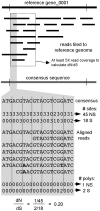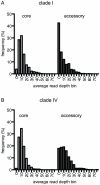Selection in coastal Synechococcus (cyanobacteria) populations evaluated from environmental metagenomes
- PMID: 21931665
- PMCID: PMC3170327
- DOI: 10.1371/journal.pone.0024249
Selection in coastal Synechococcus (cyanobacteria) populations evaluated from environmental metagenomes
Abstract
Environmental metagenomics provides snippets of genomic sequences from all organisms in an environmental sample and are an unprecedented resource of information for investigating microbial population genetics. Current analytical methods, however, are poorly equipped to handle metagenomic data, particularly of short, unlinked sequences. A custom analytical pipeline was developed to calculate dN/dS ratios, a common metric to evaluate the role of selection in the evolution of a gene, from environmental metagenomes sequenced using 454 technology of flow-sorted populations of marine Synechococcus, the dominant cyanobacteria in coastal environments. The large majority of genes (98%) have evolved under purifying selection (dN/dS<1). The metagenome sequence coverage of the reference genomes was not uniform and genes that were highly represented in the environment (i.e. high read coverage) tended to be more evolutionarily conserved. Of the genes that may have evolved under positive selection (dN/dS>1), 77 out of 83 (93%) were hypothetical. Notable among annotated genes, ribosomal protein L35 appears to be under positive selection in one Synechococcus population. Other annotated genes, in particular a possible porin, a large-conductance mechanosensitive channel, an ATP binding component of an ABC transporter, and a homologue of a pilus retraction protein had regions of the gene with elevated dN/dS. With the increasing use of next-generation sequencing in metagenomic investigations of microbial diversity and ecology, analytical methods need to accommodate the peculiarities of these data streams. By developing a means to analyze population diversity data from these environmental metagenomes, we have provided the first insight into the role of selection in the evolution of Synechococcus, a globally significant primary producer.
Conflict of interest statement
Figures







Similar articles
-
Metagenomic Analysis of the Indian Ocean Picocyanobacterial Community: Structure, Potential Function and Evolution.PLoS One. 2016 May 19;11(5):e0155757. doi: 10.1371/journal.pone.0155757. eCollection 2016. PLoS One. 2016. PMID: 27196065 Free PMC article.
-
Coastal Synechococcus metagenome reveals major roles for horizontal gene transfer and plasmids in population diversity.Environ Microbiol. 2009 Feb;11(2):349-59. doi: 10.1111/j.1462-2920.2008.01772.x. Environ Microbiol. 2009. PMID: 19196269
-
Temporal variation of Synechococcus clades at a coastal Pacific Ocean monitoring site.ISME J. 2009 Aug;3(8):903-15. doi: 10.1038/ismej.2009.35. Epub 2009 Apr 9. ISME J. 2009. PMID: 19360028
-
Metagenomic tools in microbial ecology research.Curr Opin Biotechnol. 2021 Feb;67:184-191. doi: 10.1016/j.copbio.2021.01.019. Epub 2021 Feb 14. Curr Opin Biotechnol. 2021. PMID: 33592536 Review.
-
Practical considerations for sampling and data analysis in contemporary metagenomics-based environmental studies.J Microbiol Methods. 2018 Nov;154:14-18. doi: 10.1016/j.mimet.2018.09.020. Epub 2018 Oct 1. J Microbiol Methods. 2018. PMID: 30287354 Review.
Cited by
-
Molecular detection, quantification, and diversity evaluation of microalgae.Mar Biotechnol (NY). 2012 Apr;14(2):129-42. doi: 10.1007/s10126-011-9427-y. Epub 2011 Dec 28. Mar Biotechnol (NY). 2012. PMID: 22200918 Review.
-
Reconstructing an ancestral genotype of two hexachlorocyclohexane-degrading Sphingobium species using metagenomic sequence data.ISME J. 2014 Feb;8(2):398-408. doi: 10.1038/ismej.2013.153. Epub 2013 Sep 12. ISME J. 2014. PMID: 24030592 Free PMC article.
-
Transstadial Transmission and Long-term Association of Crimean-Congo Hemorrhagic Fever Virus in Ticks Shapes Genome Plasticity.Sci Rep. 2016 Oct 24;6:35819. doi: 10.1038/srep35819. Sci Rep. 2016. PMID: 27775001 Free PMC article.
-
Mutational Studies of Putative Biosynthetic Genes for the Cyanobacterial Sunscreen Scytonemin in Nostoc punctiforme ATCC 29133.Front Microbiol. 2016 May 18;7:735. doi: 10.3389/fmicb.2016.00735. eCollection 2016. Front Microbiol. 2016. PMID: 27242750 Free PMC article.
-
Evolutionary strategies of viruses, bacteria and archaea in hydrothermal vent ecosystems revealed through metagenomics.PLoS One. 2014 Oct 3;9(10):e109696. doi: 10.1371/journal.pone.0109696. eCollection 2014. PLoS One. 2014. PMID: 25279954 Free PMC article.
References
-
- Lo I, Denef VJ, VerBerkmoes NC, Shah MB, Goltsman D, et al. Strain-resolved community proteomics reveals recombining genomes of acidophilic bacteria. Nature. 2007;446:537–541. - PubMed
-
- Hewson I, Paerl RW, Tripp HJ, Zehr JP, Karl DM. Metagenomic potential of microbial assemblages in the surface waters of the central Pacific Ocean tracks variability in oceanic habitat. Limnology and Oceanography. 2009;54:1981–1994.
Publication types
MeSH terms
Substances
LinkOut - more resources
Full Text Sources

